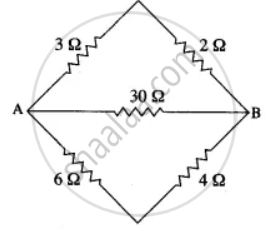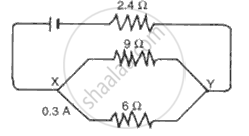Advertisements
Advertisements
Question
Consider the circuit given below when A, B and C are three identical light bulbs of constant resistance. 
(a) List the bulbs in order of increasing brightness.
(b) If C burns out, what will be the brightness of A now compared with before?
(c) If B burns out instead, what will be the brightness of A and C compared with before?
Solution
(a) The brightness of A and B is the same. C is brighter since in A and B, the same amount of current flows but the voltage gets divided into two parts. Therefore, bulbs A and B glow dimmer.
(b) The brightness of A will remain the same because voltage distribution will have no effect if bulb C burns out.
(c) Bulb A will get switched off because the current will not flow to it if bulb B burns out since they are in a series circuit. The brightness of C will remain the same because the same current will continuously flow through bulb C.
APPEARS IN
RELATED QUESTIONS
The atoms of copper contain electrons and the atoms of rubber also contain electrons. Then why does copper conduct electricity but rubber does not conduct electricity?
Find the potential difference required to pass a current of 0.2 A in a wire of resistance 20Ω
Calculate the equivalent resistance between A and B in the adjacent diagram.

The following table shows the current in Amperes and potential differences in Volts.
- Find the average resistance.
- What will be the nature of the graph between the current and potential difference? (Do not draw a graph.)
- Which law will the graph prove? Explain the law.
| V (volts) | I (amp) |
| 4 | 9 |
| 5 | 11.25 |
| 6 | 13.5 |
A current of 0.3 A is flowing through a branch of 6 Ω resistors in a junction as shown in fig. . Calculate the
(a) P.d. across the junction XY,
(b) Current flowing through 9Ω and 24Ω
( c) P.d. across 24 Ω resistor, and
( d) e.m.f. of the cell.

What is the function of a step-up transformer?
State whether the following statement is True or False:
The SI unit of charge is the coulomb.
MCB is used to protect household electrical appliances.
Electric current passes through a metallic conductor due to the movement of ______.
